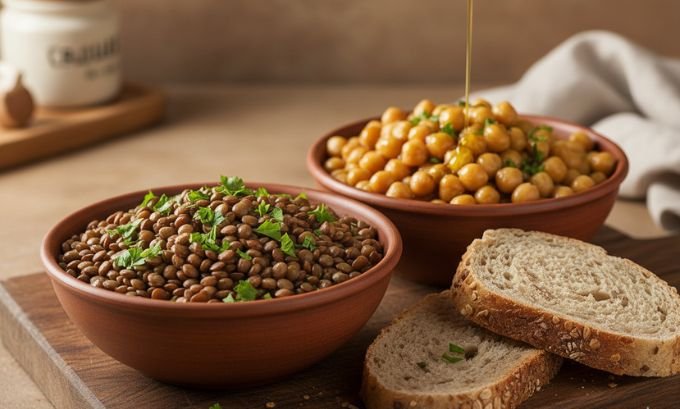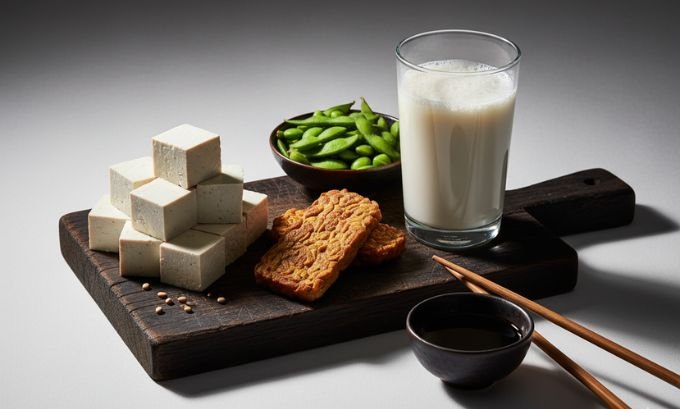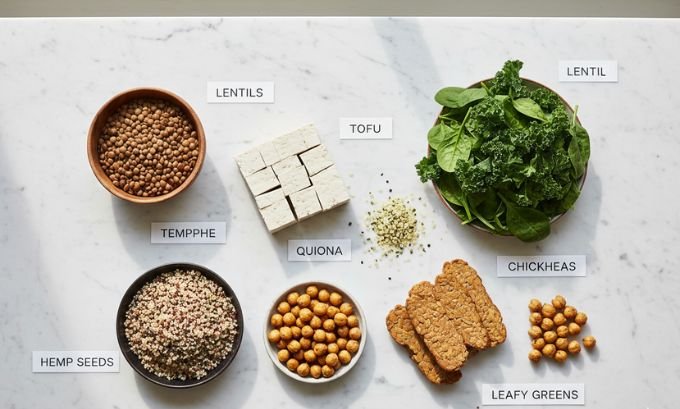Looking for ways to boost your protein intake without meat? High-protein vegetarian foods can provide all the essential amino acids your body needs for energy, muscle recovery, and overall health. From legumes to superfoods like quinoa and hemp seeds, plant-based proteins offer diverse options for anyone aiming to meet their nutritional goals.
Table of Contents
What Are High-Protein Vegetarian Foods?
High-protein vegetarian foods are plant-based sources that supply significant amounts of protein per serving.
These foods rely on plant-based protein, which provides the amino acids needed for muscle maintenance, repair, and muscle protein synthesis. Unlike animal protein, plant-based options often vary in protein quality, which is measured by tools like the Protein Digestibility-Corrected Amino Acid Score (PDCAAS). This score helps you understand how efficiently your body can use the protein from a given food.
Examples:
- Legumes: Lentils, chickpeas, black beans, peas
- Soy Protein: Tofu, tempeh, soy milk
- Grains & Seeds: Quinoa, hemp seeds, chia seeds
- Novel Sources: Mycoprotein (Quorn)
Top High-Protein Vegetarian Foods and Their Benefits
1. Legumes: The Everyday Protein Heroes

Legumes are versatile, affordable, and packed with protein.
Legumes like lentils, beans, and peas are staples for many vegetarians because they offer 15–18g of protein per cooked cup. They’re also rich in fiber, iron, and complex carbohydrates, making them a balanced protein source.
What I Like / Strengths:
- Affordable and widely available
- Excellent for heart and gut health
- Can be used in soups, salads, stews, and spreads
Areas for Improvement:
- Some legumes contain anti-nutrients like phytates that may reduce mineral absorption
- May cause bloating for sensitive individuals; soaking and cooking thoroughly can help
Pro Tip: Combine legumes with grains (like rice or oats) to form complete proteins, ensuring all 9 essential amino acids are present.
2. Soy Protein: The High-Quality Plant-Based Protein
Soy protein is a complete protein with a high PDCAAS score, making it one of the best vegetarian protein sources.

Soy-based foods — including tofu, tempeh, and soy milk — contain all essential amino acids. Studies show soy protein supports muscle protein synthesis comparably to animal protein, making it ideal for athletes and active individuals.
Strengths:
- Complete protein
- High digestibility (PDCAAS ≈ 1.0)
- Supports bone and heart health
Areas for Improvement:
- Some people may be allergic to soy
- Highly processed soy products may contain additives; choose minimally processed forms
3. Quinoa: The Superfood Grain
Quinoa is a rare plant-based complete protein, meaning it provides all essential amino acids.
With roughly 8g of protein per cooked cup, quinoa is versatile, gluten-free, and nutrient-dense. It’s particularly rich in magnesium, manganese, and fiber, complementing its protein content.
Strengths:
- High protein quality
- Gluten-free and easy to digest
- Great base for salads, bowls, and side dishes
Areas for Improvement:
- More expensive than common grains
- Slightly higher carbohydrate content, which may need monitoring for certain diets
If you want to learn more about high-protein vegetarian foods, you can check out these articles 👉 mindjournal.co
4. Hemp Seeds: Tiny Nutritional Powerhouses
Hemp seeds are rich in protein, healthy fats, and minerals.
A 3-tablespoon serving provides around 10g of protein and a perfect balance of omega-3 and omega-6 fatty acids. Hemp seeds are also easily digestible and can be sprinkled over smoothies, oatmeal, or salads.
Strengths:
- Nutrient-dense with multiple vitamins and minerals
- Supports heart and brain health
- Easy to incorporate into daily meals
Areas for Improvement:
- Higher fat content may increase calorie intake
- Can be slightly pricey compared to legumes
5. Mycoprotein (Quorn): Sustainable Protein from Fungi
Mycoprotein is a high-protein, sustainable alternative to traditional plant proteins.
Quorn products are derived from fungi, providing 13–15g of protein per serving. They have a high PDCAAS and are considered a complete protein, making them a strong option for vegetarians looking for variety.
Strengths:
- Sustainable and eco-friendly
- Low in saturated fat
- Supports muscle growth and repair
Areas for Improvement:
- Some products may contain additives or binders
- Not suitable for those with fungal allergies
For those looking to stock up on high-protein vegetarian staples like tofu, tempeh, and soy-based pantry items, check out the selection at TokyoMart.store
Comparison Table of High-Protein Vegetarian Foods
| Food Source | Protein per Cup | Complete Protein | PDCAAS | Best Uses |
| Lentils | 18g | No | 0.52 | Soups, stews, salads |
| Chickpeas | 15g | No | 0.78 | Hummus, curries, salads |
| Tofu (Soy Protein) | 20g | Yes | 1.0 | Stir-fries, scrambles, smoothies |
| Tempeh (Soy) | 31g | Yes | 1.0 | Sandwiches, bowls, grilling |
| Quinoa | 8g | Yes | 0.78 | Salads, side dishes, breakfast |
| Hemp Seeds | 10g | Yes | 0.66 | Smoothies, yogurt, baking |
| Mycoprotein (Quorn) | 13–15g | Yes | 0.99 | Stir-fries, sandwiches, meals |
Personal Experience: How I Use High-Protein Vegetarian Foods Daily

As a nutritionist, I often suggest clients start the day with a quinoa porridge topped with hemp seeds, providing a complete protein breakfast. For lunch, lentil or chickpea salads offer both fiber and protein, keeping energy steady. In the evening, tofu stir-fries or tempeh bowls ensure adequate protein intake for muscle protein synthesis after workouts.
This approach balances protein quantity, quality, and variety, proving you don’t need meat to meet daily protein needs.
Frequently Asked Questions (FAQ)
1. Can vegetarians get enough protein without meat?
Yes! Combining legumes, grains, soy, quinoa, hemp seeds, and mycoprotein can easily meet daily protein requirements.
2. What is the best complete plant protein?
Soy products, quinoa, hemp seeds, and mycoprotein are all complete proteins containing all 9 essential amino acids.
3. Are plant proteins as effective as animal proteins for muscle growth?
Yes, especially soy protein and mycoprotein, which have high PDCAAS scores and support muscle protein synthesis.
4. How do I combine foods to get complete protein?
Mix legumes with grains (e.g., rice and beans) or seeds/nuts with grains. This ensures all essential amino acids are covered.
5. Are high-protein vegetarian foods good for weight loss?
Many are! Legumes, tofu, quinoa, and hemp seeds are nutrient-dense, filling, and support metabolism.
6. Can I rely on protein powders instead of whole foods?
Powders can supplement your intake, but whole foods provide fiber, vitamins, minerals, and phytonutrients that powders lack.
7. Are there any risks with soy protein?
Most people tolerate soy well, but allergies exist. Choose minimally processed soy and avoid overconsumption.
Conclusion
High-protein vegetarian foods are versatile, nutrient-dense, and sufficient to support health, energy, and muscle growth. By including legumes, soy, quinoa, hemp seeds, and mycoprotein in your diet, you can achieve optimal protein intake while benefiting from additional vitamins, minerals, and fiber.
Take Action: Try creating meals with one complete protein source and one high-protein complement daily. Experiment with recipes to make plant-based eating both delicious and sustainable.
Author Bio
Dr. Emma Lawson, RD, PhD
Emma Lawson is a registered dietitian and nutrition researcher specializing in plant-based diets and sports nutrition. With over 10 years of experience, she has helped athletes, vegetarians, and families optimize their diets for health, performance, and longevity.


